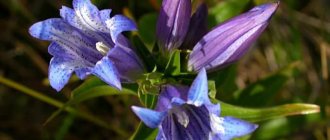The article presents varieties of lilies with names, photos: a large list.
Cultivators of lily varieties in their territories have long known that these gorgeous flowers, for the most part, are famous for their unpretentiousness and do not require special care. There are so many lilies that not all of them naturally have these qualities. Flowers, identical in appearance, can differ according to such whims as, for example, place of residence, soil composition, and also how to propagate flowers. This material provides information about the varieties of lilies and their characteristic features. Happy reading!
Varieties of lilies with names: the main international classification of lilies
Varieties of lilies with names: the main international classification of lilies
At the end of the 20th century, the total number of lily varieties numbered ten thousand, and another 200-300 varieties are added annually. How are new species created? Hybrids are crossed with each other or with pure varieties. Since lilies had and have strong differences from each other in how to care for them and in other ways, in the middle of the 20th century they adopted an international classification of lilies, which has come down to us with some amendments.
Classification. Asian hybrid varieties. Curly lilies. Snow-white varieties. American varieties. Long-flowered lilies. Tubular and Orleans varieties. Oriental lilies. Interspecific hybrid varieties. Wild lilies. Other hybrid varieties.
Flower growers often invent their own classifications. Frequently encountered classifications: according to the color of the flowers, according to the growth of the stems, according to the structure of the flower (doubleness is present or not), whether there is a scent or not, according to resistance to frost, according to the ways of reproduction.
Bush lily - planting and care
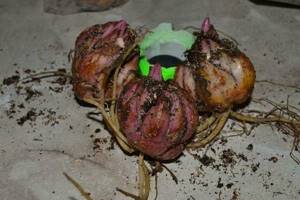
Before planting, it is necessary to dig up the soil. The bulbs are inspected. The dried roots are cut off, the sections are covered with charcoal (it must be crushed in advance), since the onions and roots are deprived of the integumentary scales that protect them, they do not like to be overdried.
Before planting, dried onions need to be mulched with damp material so that they absorb water. The planting depth is determined by the following characteristics: the size of the bulb, the formation of roots at the stems, and the composition of the soil.
Typically, onions are planted so that the depth is 3 times the diameter of the onion. But even here there are exceptions - varieties that form a rosette of leaves near the ground: “Snow White”, “Catsby”, “X terracotta”.
Their bulbs need to be deepened by 2-3 cm. Important: the top of the scales should be almost at the surface layer of the soil. Bulbs with large shoots: “Kudrevataya”, “Hansona”, “Willmott”, “Henry” should be planted at a greater depth than conventional varieties.
Bulbs with stem roots are planted most deeply.
The best way: planting the bulbs as deep as possible. Because: a lot of water is hidden below. In the autumn season, temperature conditions are higher inland. For this reason, root growth takes longer.
What is reassuring about frosts in the spring is that almost before the onset of spring, deep-planted onions experience a significant slowdown in the growth of shoots that bear flowers.
To determine the depth of the bulbs, you need to know the composition of the soil and its type. If planting is carried out on sandy soils, then the bulbs must be planted deeper.
In advance of planting the bulbs, river sand is poured under them to protect them from harmful insects and diseases that can affect the seedlings. Next, plant the onion on the sand and straighten the roots.
To determine the spacing between bulbs when they are planted, you need to look at the size and growth of the bulbs. The largest bulbs are planted with an interval of 20-25 cm between each other. Smaller bulbs are planted at intervals of 10-15 cm.
After the flowers have been planted, it is necessary to give them a good watering. Watering is necessary to ensure that the bulb is fixed in the soil. To smooth out the root system, watering will also affect the active growth of the plant. Watering is not carried out if the soil is already moist.
Asian varieties of lilies with names
These hybrid varieties gave rise to the breeding of new lilies, and currently Asian hybrids are the group that contains the largest number of varieties. Varieties of this group were created using lilies from Asian lands. There are more than five thousand varieties in this group. Lilies are famous for their different colors; they are the most unpretentious of all lily flowers.
The group includes low-growing varieties, their height is up to 40 cm, tall varieties - up to 150 cm. What color does this group have: the whole color palette, but blue and blue ones have not yet been bred. The coloring of the flowers is monochromatic, 2-3 colors, and the flowers are also decorated with strokes, dots, and specks.
The shape of the flowers is varied, some are double. They are not giants in size, their diameter is 10-15 cm. The varieties bloom for about 14 days. Flowers come into this world from the first days of June to the first 15 days of August.
This group is rightfully considered the most unpretentious, because they are cultivated from the southern regions to the subarctic regions. There is no need to shelter for the winter in mid-latitudes; reproduction occurs by any means.
These lily varieties have no aroma at all. These hybrids do not tolerate lime in the soil; neutral or slightly acidic soil is required for planting them. They can grow well both in partial shade and in the sun.
Varieties.
"Lion Heart".

Asian varieties of lilies with names
Flower coloring is called avant-garde. One plant can produce up to 12 star-shaped flowers. Flowering occurs in July-August.
"Marlene."

There are rumors among people that there are lilies in the shape of pyramids; their varieties are capable of forming up to 200-300 flowers on one bush. This rumor appeared thanks to our variety. Another name for these lily flowers is bush flowers. All of these names are misleading because lilies almost always produce only 1 stem. The second explanation for this erroneous opinion is that at times fasciation occurs in species—several stems grow together. As a result, naturally, the stem becomes strong and forms up to 200-300 flowers. It is not programmed and does not depend on any factors. You can see this type of flowering in the lilies “Marlene”, “Aphrodite”, “Ilia”, “Red Hot”, “Fleur”.
"Lollipop."

This lily is highly resistant to frost down to -25 degrees. Without even hiding! The flower is very delicate and strong. Flowering period is 70 days after shoots appear. The inflorescences are medium-sized, bearing 5-6 flowers.
"Tribal Dance".
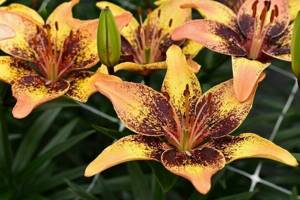
The coloring is original, exotic, no other lily has anything like it. Flowering occurs in the second or third summer month. Reaches a height of 1.1 m.
Landing

Growing lilies is a very exciting process. It should be remembered that such a plant has an extremely negative attitude towards the transplantation procedure.
In this regard, it is recommended to grow it without transplanting for several years. To plant lilies, experts advise choosing a fairly well-lit place, protected from strong gusts of wind.
The most suitable soil for this type of plant should be loose, well-drained and rich in nutrients.
In order for the flowers to grow better and hurt less, about 4 weeks before they are planted, you need to add ash to the soil and dig everything thoroughly.
Humus and peat are also suitable for fertilizing the soil, as well as other mineral fertilizers that can be purchased at a specialized store.
When choosing a lily bulb in a flower shop, you definitely need to find out exactly what species this plant is related to.
The fact is that the care features of different types of lilies are somewhat different. You should opt for the strongest onions, on the surface of which there are no signs of damage or rot.
It is worth considering that the minimum root length for bulbs of these colors is 5 cm.
Landing Features

Lily bulbs need to be planted in autumn or spring; in some cases, this procedure can be carried out in the summer. Planting in spring is a fairly popular option.
In this case, the bulb will be able to take root well, become stronger and not freeze during wintering.
But experts still advise planting lilies in the autumn. The roots have time to set even before the first frost. However, the grower should take all necessary measures for the successful wintering of the bulbs.
Planting of such flowers is usually done in the first autumn month. But at this time, the gardener may have difficulty purchasing high-quality bulbs. During this period, you can replant the lilies available on the site.
It should be remembered that it is necessary to plant such plants in spring and autumn according to the same principle.

The first step is to prepare the hole by digging it. You need to pour sand into the bottom of the hole, and then lower the onion into it. The roots must be carefully straightened, and then sand must be poured into the hole again.
The top of the bulb must be covered with soil, and upon completion of planting, the plant must be watered sufficiently.
The planting depth directly depends on the type and variety of lily. So, it can be equal to 15–30 cm.
Quite deep planting delays the beginning of flowering, but at the same time such a lily produces a larger number of offspring.
By the onset of autumn, such a plant has time to grow, and if necessary, at this time the lily can be transplanted and simultaneously multiplying it.
However, not in all cases it is necessary to wait for the onset of the autumn period, so the lily can be transplanted immediately after the plant has flowered.
Features of transplantation:
- you need to dig up the flower using a pitchfork (this will protect the bulbs from damage);
- the root system must be doused with water;
- then young shoots are separated and immersed for some time in a weak solution of potassium manganese;
- the roots need to be trimmed so that they are about 10 cm long;
- lilies are planted in the soil.
Low-growing lilies: varieties with photos
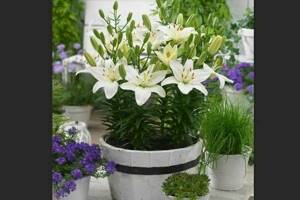
Low-growing lilies: varieties with photos. Belem
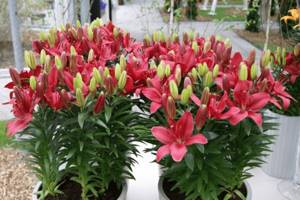
Buzzer
The low-height variety is used for flowerpots that hang on terraces, balconies, and rooms. Flower growth is 50-60 cm, maybe 40 cm.
Sellers with a guilty conscience pass off these low-growing lilies as new pot lilies or lilies intended for pots. Although the world has known most of these varieties for a long time. Some people plant different bulbs in a pot, and they really get a gorgeous bouquet of small lilies of different colors. This bouquet blooms for only 14 days. If you want your lilies to bloom much longer, about 30 days, then grow short oriental hybrid lilies for this.
How do you know if a low growing Asiatic lily is present? Everything is very simple: the name of the variety must contain the words “Pixie” and “Tiny”.
Low growing lilies: “Belem”, “Bazzer”, “Sorocaba”, “Spider”, “Curitiba”, “Ivory Pixie”, “Juan Pesao”, “Rio de Janeiro”, “Lady Like”, “Matrix”, “ Tiny Chost."
Terry lilies: varieties with photos and names
Currently, there are a huge number of beautiful double Asiatic lilies. They are winter-resistant, unpretentious to care, and can be cultivated almost throughout the entire Russian territory.
Variety "Aphrodite".
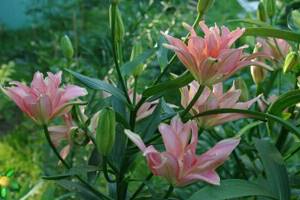
The height of this flower is 1.1 m, the bud opens at the base by 15-18 cm. The average stem forms approximately 8 flowers, under more favorable conditions there can be 20 flowers. Moreover, the bush can be 0.5 m wide.
Variety "Aaron".
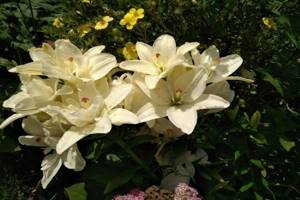
The stem is of medium height - 70-80 cm, bears large double flowers of snow-white color. Flowering occurs in June and July.
Variety "Sphinx".
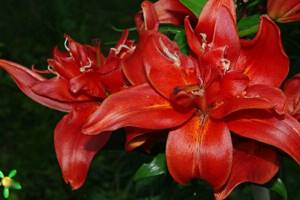
The height of the stem is 1.1 m. It bears erect, densely red double flowers, their diameter is 15-18 cm. Flowering occurs in June-July.
Variety "Fata Morgana".

Sun-colored flowers are pleasing to the eye. Flowering occurs in July-August. Stem height is 90-95 cm.
Variety "Double Sensation".
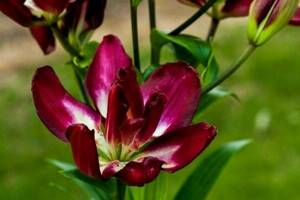
The petals of this variety are both double and two-colored. The flowers are medium in size. Flowering occurs in July-August.
Variety "Elodie".

Double flowers. Height - 45-50 cm, active flowering, a lot of ovaries.
Variety "Mistery Dream".

The flowers are double, light green in color, and have dark specks in the central part. The flowers become double in the second year of life. The layers of the flower open gradually, and a new variety of flower can be seen every day.
Secrets of success
In winter, in the absence of snow and severe frosts, the corms can freeze and die. To avoid this, it is necessary to cover the bushes with fallen leaves or other suitable material at the end of autumn. Frequent replanting of the plant is not indicated. It is recommended to change the location of Ixiolirion no earlier than after 5–6 years.
The plant reproduces more readily and quickly by corms than by seeds. Under favorable conditions, one perennial can produce about 10 daughter corms over the summer. They are very poorly stored. Therefore, they should be planted in the ground without delay - in August or September. Large corms can be deepened by 10–12 cm, small ones by no more than 5–6 cm.
Seeds are planted in open ground in spring or early summer (April - July). The optimal temperature for germination is +15°C. Shoots should appear in 2–3 weeks. The seedlings will bloom only in the third year.
Ixiolirion, planted in groups of 10–15 corms, looks especially interesting on a personal plot. On an alpine hill it goes well with bright tulips, delicate daffodils and primroses.
Black lilies: varieties, description
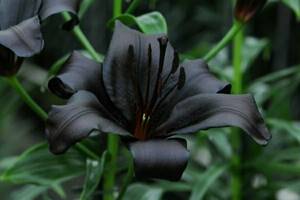
These flowers inspire mystery with their coloring. Also classified as Asian hybrid varieties. Lilies are not completely black in color, they are dark burgundy or dark purple. But still, these flowers are full participants in the black lily “community”.
Variety "Landini". This is the blackest lily to date. As the lighting falls, so will the color of the flower - from dark burgundy to black-gray.
Variety "Mapira". Very dark coloring of flowers, almost black. The height of the stem is 130 cm. Flowering occurs at any time in the summer, it all depends on the weather conditions.
Variety "Nightrider". The lily is almost black in color, not completely Asian, more reminiscent of something mixed from Asians and tubular hybrid varieties.
Variety "Black Out". The name of the variety already wants to speak for itself about the color of the flowers, but that was not the case - the lily is dark red in color, has dark spots on the petals and a black core.
Curly varieties of lilies: catalog

Flowers can be grown safely in partial shade. They will not withstand prolonged exposure to direct sunlight. Frequent transplants are also not recommended, lilies do not like it, transplants are done once every 10 years. And so, this variety is famous for its unpretentiousness and resistance to the winter season, even in open beds in the northern Russian regions. Lilies can grow in any soil and have immune protection to fight fungus.
These flowers were obtained by crossing the Martagon variety with other varieties. The flowers appear before us in the form of a turban, small in size - 5-10 cm, of varied colors. There are even lavender lilies. Flowers of this variety have a light, airy aroma.
Varieties: “Lankongensee”, “Claude Shride”, “Maroon King”, “Arabian Knight”, “Gaybird”, “Russian Morning”, “Martagon Album”, “Sunny Morning”.
Planting scheme
Astilboides is a moisture-loving plant that does not tolerate drought. If the soil near the flower is subject to frequent drying out, then it will not be able to form inflorescences and will grow very slowly
In connection with these growth characteristics, experts recommend paying special attention to the choice of planting site, which should be maximally protected from direct sunlight and have constantly moist soil.
Beginner gardeners must understand that this flower is a very large plant, and therefore requires a large amount of free space. The flower reaches its maximum size 5 years after planting, and the occupied area of one bush can be about 3.5 m2.
These parameters must be taken into account in order to avoid crowding of green spaces.
Due to its unpretentiousness, the flower feels good in any type of soil, but still prefers nutritious loams. When planting a flower, experts recommend using a nutrient mixture consisting of garden soil, peat, humus and river sand. Due to the presence of a superficial root system, the planting hole should not be deep, but very wide.
During planting, it is necessary to straighten the root system as much as possible and sprinkle it with a nutrient mixture, which must be carefully compacted near the flower. Planted plants must be watered abundantly with clean and settled water, and to prevent the root system from drying out, the entire area near the flower should be mulched with peat or crushed tree bark.
Healthy seedlings should have a strong root system, without signs of rot or fungal diseases. For maximum rooting, before planting, the roots of the plant must be soaked in a special solution that accelerates growth and formation of the root system.
Principle of reproduction
This plant reproduces by seeds or root division. You have to tinker with the seeds, and no one guarantees a hundred percent result due to low germination. Moreover, the growth of such a young plant is too slow, and flowering is possible only after four years. As for rhizomes, this method is considered simpler and more practical. You just have to wait for spring and dig up a piece of rhizome. Then cut off a small part with 3-4 buds from it, treating the cut areas with ashes. In order for the flower to take root well, you need to place the root horizontally in the ground somewhere to a depth of five centimeters.
Planting astilboides in your garden
To purchase a seedling, we recommend contacting retail garden centers. The timing of this event coincides with the departure of spring frosts. Before planting, rhizomes are treated with epin, root and humate. This procedure is carried out without removing the seedling from a special planting container, but simply by lowering it into the solution for 30 minutes and pulling it out when the bubbles stop coming out. Then they choose a suitable place where there is a lot of shade or partial shade, and where the proximity to a body of water will be wonderful. After planting, the ground around the flower is covered with a five-centimeter layer of mulch. In the first days, the seedling is cared for, namely:
• weeds will fall;
• watering is carried out in dry weather;
• renew the mulch.
Next year there is no need to carry out these procedures, since the falling leaves will serve as a good mulch, will delay the evaporation of water and drying out of the soil and will not allow weeds to germinate. But if the summer turns out to be hot and dry, then you should not forget about watering, despite the age of the plant.
Astilboides is sometimes used as a tapeworm. This perennial does not require special attention. It stands out elegantly among its flower neighbors, which grow nearby and create a certain background for it. Astilboides are also planted among bushes whose leaves will become brightly colored in the fall. This applies to viburnum, bladderwort, and barberry. This flower will look very beautiful on the coast of water bodies, especially among artificial stonework. And if sedge grows nearby, this area will become a real island of wild nature.
Snow-white varieties of lilies

Flowers from this group are often called “European hybrid varieties” because they originated from wild varieties that grow in the European part: “Kindidum”, “Chalcedony”. These lily varieties require different care. The bulbs are planted 3-5 cm deep. The resting stage is short, usually it occurs in August days. At this time, if replanting is necessary, replant. In the days of September, a rosette of leaves should appear, which in the spring season will give rise to a shoot that will bloom.
These plants are at risk of fungal infections; lilies must be covered for the winter. Likes to live in the sun, the soil should be alkaline. The stems reach a height of 1.8-2 m, the flowers are in the form of tubes or funnels. The flowers are white or light in color. Lilies are renowned for their very strong and delicious aromatic qualities. Varieties: "Apollo", "Testacium".
Growing Hosta from Seeds
How to grow hosta in a pot.
Hostas are propagated by dividing the bush, seeds, and also by cuttings. For those who prefer growing hosta with seeds, you should know that growing hosta in this way depends on pre-sowing treatment of the material with growth stimulants (soaking for half an hour in epin, root, zircon or aloe juice), since the germination capacity of hosta seeds is weak - 70-80% . To improve germination, some gardeners advise resorting to the stratification method (keeping seeds in the cold for a month). The second very important success factor is the sterility of the substrate, which should be free of fungi and other microorganisms, otherwise the seedlings may grow sick, so it is best to buy the substrate in specialized stores. The substrate should include perlite, peat and vermiculite.
But before we go any further, let me convince you of the interest in seeding. Growing green spring fertilizer will have the following benefits. Enrich your soil with easily decomposed organic matter and boost your future crops. Maintain high humidity in the immediate area and promote soil aeration.
- Protect the soil from erosion and drying out.
- Limiting the development of weeds.
- Participate in crop rotation and thereby reduce the risk of diseases and pests.
Green manure is usually sown from February to April, but can also be sown in the summer after harvesting crops such as potatoes.
In April-May, a layer of drainage is placed in a pot pre-treated with medical alcohol or a solution of potassium permanganate, the substrate is poured in and it is well moistened. Then scatter the hosta seeds over the surface, sprinkle them on top with a layer of substrate 5-7 mm thick, compact it slightly and, to retain moisture, cover the pot with glass or film. During germination, the soil temperature should be 18-25 ºC, and then seedlings will appear within two or three weeks. Protect seedlings from direct sunlight, provide them with moderate watering, and remove condensation in a timely manner. The seeds don't need bright light, so keep them in light shade until they sprout, but then place them in a well-lit area.
Growing hosta in open ground - propagation
If the soil is too packed, you can unpack it using a herb or spatula without returning the soil. Take a bucket of several buckets of seeds and the amount of seeds for your surface. Mix well. Owl on the fly. Below is the quantity. Reach out the back of the rake to bring the seeds into contact with the soil. Water if necessary. Usually winter humidity prevents you from watering, do so according to the soil and forecast.
- Start by removing the mulch from the flatbed.
- If you don't have mulch, use a hook to remove any weeds.
- Pass the hook through to break up any lumps and straighten the parcel.
Small tip: For your seedlings, a teaspoon to low is about 3 grams of seed.
Seedlings should be planted in separate pots after a couple of leaves appear: the seedlings are transferred to soil one-quarter covered with sand. To moisten the picked seedlings, bottom watering is used: the hosta in the pot is placed in a deep tray with water and remains there until the top layer of soil gets wet. Now the seedlings need to be hardened: remove the film or glass for several hours. After a week, remove the covering completely and expose the host to fresh air for a short time, provided that the temperature is not lower than +18 ºC. Keep in mind that hosta seedlings develop very slowly, and in general, hosta grown from seeds often loses its varietal characteristics.
Tip 2: Mixing seeds with potting soil will make it easier to visualize planting areas. The three most commonly used spring green manures are phacelia, spring vetch, and mustard. All three will create significant amounts of biomass.
- Cost per m²: about 2 cents.
- Sowing density: 1 gram per m².
- Cost per m²: about 5 cents.
Little tip 3: Mix these three green manures together, you know my theme: Variety = Protection.
American hybrid varieties of lilies
Why does this section of hybrid varieties have this name? Everything is obvious here - the varieties come from North American varieties, these are: “Columbia”, “Leopard”, “Canadian”. Although the flowers are beautiful, they are not very appreciated and are grown in America.
The flowers of this species are enlarged, in the shape of bells or turbans, often in two colors, their surface is covered with a large number of dots and streaks. Lilies emit a light scent; they like to grow in partial shade; replanting from place to place does not suit them. Flowering occurs in the second summer month. They need to be covered for the winter season.
Unusual varieties: “Lake Tulare”, “Afterglow”, “Shaksan”, “Cherrywood”.
Oriental hybrid varieties

Plants of this group are rightfully considered the most decorative. They are of average height, but their flowers are large, reaching a diameter of 30-35 cm. Flowering occurs late, in August-September days. The flowers are simple and double, most of them are painted in pink, red, and white shades. There is sheer variety in the shape of the flowers.
The distinctive feature of these hybrid varieties is an edging of a different color from the flower or a stripe in the center of each petal.
The varieties are whimsical. They can be damaged by viruses, plus plants love warmth. If you grow lilies in mid-latitudes, they will need to be covered during the winter season, but even under cover they may not survive. But there is also a positive moment. Among these plants, there are low-growing flowers that are successfully cultivated in containers and will be preserved in winter in places that do not freeze.
Varieties: “Magni Cors”, “Garden Party”, “Mona Lisa”, “Entertainer”.
But tall plants can also be cultivated well in mid-latitudes if bulbs are dug up for the winter in the autumn season.
Varieties: “Stargazer”, “Salmon Star”, “Casablanca”, “Le Rev”, “Crystal Star”, “Lovely Girl”, “Barbados”, “Muscadet”. Terry lilies of amazing beauty emerge only 3-4 years after planting.
Varieties: “Broken Heart”, “Miss Lucy”, “Polar Star”, “Distant Dram”, “Double Surprise”, “Soft Music”. These hybrid varieties can bloom for about 30 days or more. This is their main difference from Asian varieties.
Possible difficulties
The plant blooms poorly, the leaves have faded and lost color.
Reason: 1) not enough light, 2) too poor soil, 3) lack of fertilizing.
Ixiolirion stopped growing, the leaves and stems began to wither, and the root system began to rot.
Reason: 1) the corms were affected by rot, 2) lack of drainage, 3) the location of the plant on the site was incorrectly chosen (lowland).
The perennial did not produce new shoots in the spring
Reason: 1) the root system froze in winter due to lack of shelter.
The leaves wrinkled, the stems began to turn yellow and become woody.
Reason: 1) drying out of the soil (insufficient moisture), 2) prolonged exposure of the plant to direct sunlight.
Subscribe and receive descriptions of new species and varieties in the “bulb and corm” section by email!
Ixiolirion montane, also known as mountain lily, or lavender lily, is a very interesting flower that is easily propagated by seeds. But when can they be sown and how to do it correctly?
The plant is a perennial, wintering well in the middle zone, however, provided that it does not flood. It is especially important to monitor this during the rest period. It begins in July, when the ground part dies off. If the flooding is short-term, the plant will not be damaged. It does not need shelter even in winters with little snow.
to grow this plant from seeds , and they can be sown no later than July, so that the emerging seedlings have time to prepare for winter. Sowing is normal, but it is important not to forget to moisten the soil. Probably, in this case, it is better to sow in a transparent container with a lid, which is placed in partial shade in the garden. When the seedlings grow a little, you need to move the crops to a more open, warm place, since Ixiolirion is light-loving. Although it grows and blooms well even with slight shading, it is important that the mountain lily warms up well at noon. Next - the usual care as for small bulbs.
Corms grown from seeds will produce flower stalks for 3-4 years. But the big advantage of these plants is that they grow more viable, adapted to existing conditions. With sufficient heat they self-seed.
Ixiolirion prefers moisture-permeable, nutrient-rich soil . If the soil is sandy, you should not improve it with peat, ixiolirion does not tolerate high acidity, it is better to add clay and turf soil. In a heavy clay area, sand will help correct the situation.
In good conditions, ixiolirion grows fairly large corms up to 6-7 cm high (their diameter is slightly smaller), which bloom profusely for up to three weeks. Despite the fact that in one season an adult bulb can produce up to ten children, the lily needs to be divided approximately once every 5-6 years. The best time is during the rest period, but no later than mid-September.
LA-lilies
These plants are famous for their decorativeness and unpretentiousness, they tolerate the winter season in open beds, have immune protection against diseases, and the flowers are also beautiful with their pleasant aroma. From Asians they inherited durability and a large amount of color; from long-flowered plants they inherited the rapid development and grace of enlarged flowers. Flowering occurs in the second or third summer month. Famous varieties: “Bestseller”, “Fangio”, “Samur”, “Indian Diamond”, “Ceb Dazzle”.
Tree lily plants
Naturally, these are not trees of any kind. These lilies do not have a trunk, which is woody, and in the southern regions they generally die in the winter season. So why tree-like then? They are connected with a tree only by their enormous growth, which flowers do not have. In the Ural and Moscow region, plants may not reach a height of 2.5 m, even if you take very special care of them. Flowers can reach this height only in the south of our homeland. In middle latitudes, lilies grow up to 1.5-1.7 m, which is also very good.
Moreover, special agricultural technology is not needed, and plus the plants have excellent winter tolerance. Some tubular varieties can also grow to the size of a giant.
Varieties: “Debbie”, “Labrador”, “Manissa”, “Pearl Prince”, “Sucinto”, “Empoli”.
Appearance and location in the garden
Lily flowers are very beautiful and spectacular.
They have several large petals that bloom in the daytime and are shaped like an eastern bowl. The colors of bush lilies are especially pleasing to the eye: purple, tangerine red, white, deep pink. Unfortunately, lilies are devoid of fragrance. And this is undoubtedly a plus if you want to plant them in the garden next to other flowers: asters, phlox, echinaceas. Bush lilies prefer loose and nutritious soil that is slightly acidic or neutral. Plant them in an area that is well lit and warmed by the sun. In the absence of such a place, flowers can grow in the shade. However, do not plant the plant under large tree canopies: it will suffer from lack of light. Carefully monitor the soil of the flowers: you should not allow a lot of weeds in it.
Tiger varieties of lilies
The ancestor of this lily section is “Tiger (Lanceolate) lily.” The turban-shaped flower is orange in color and has many purple spots.
The most amazing variety, “Fluffy Leopard,” has double flowers. It is famous for its unpretentiousness and frost resistance; each stem forms 12-20 ovaries.
Another famous variety, the Flore Pleno variety, also has double flowers. Varieties of a different color, but with spots: yellow “Citronella”; there are also pink-colored varieties.
Bulbous varieties of lilies
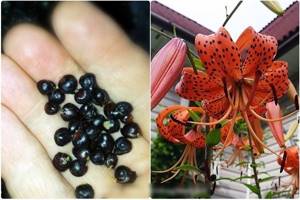
These lilies have a tiger-like coloration, but the flowers are tube-shaped. The main feature of this group is the formation of a large number of bulbs (aerial bulbs) in the leaf axils, through which the process of propagation of lilies can be carried out. Most Asian varieties can be propagated in the same way, for this feature they were given the name “Bulbbearing”. Tiger varieties also form a large number of aerial bulbs.
Blue varieties
What can we say here - such varieties do not exist. This is all a marketing ploy by unscrupulous sellers; they simply process photographs of lilies in programs to make them appear blue. But don’t be upset: craftsmen from Japan, as always, will save the day - they promised to show blue lilies to the world by 2021.
In conclusion, it is worth saying that in no material that is given to you, or that you find on your own, no one will convey the descriptive characteristics of lilies and their aromas as accurately and clearly as you yourself. Just plant these flowers and experience everything in practice. But I think our article will also be useful to you in choosing a variety. Thank you for your attention!
Varieties of lilies
Diseases and pests

When growing lilies, you need to take into account that plants may need protection from diseases and pests.
The flower is sometimes attacked by insects:
- lily rattle;
- lily miner.
Insecticides are used for control.
The flower can be affected by fungal diseases (for example, gray rot), which occurs as a result of excessive soil moisture. Gray rot is indicated by brown spots and a gray coating; to preserve the flowers, you need to spray them with fungicides.
Viral diseases inhibit the growth of flowers and deform leaves. Unfortunately, no treatment for them has yet been found - affected bulbs and flowers are immediately dug up and burned.






